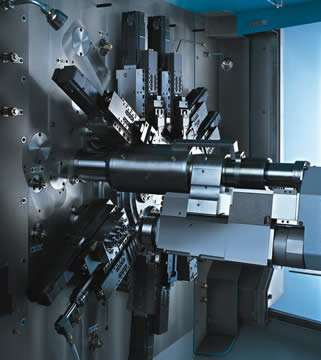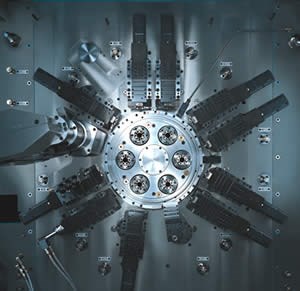Sticker Shock Relief For The CNC Multi-Spindle
To bridge the gap between traditional multi-spindle technology and full CNC, Index Corporation (Noblesville, Indiana) has developed the MS22C, a six-spindle CNC multi for the medium-complex workpiece market, which has been dominated by the cam-controlled multi-spindle automatics and simple sliding and fixed headstock automatics.
As accuracy demands and the need to produce parts complete without secondary operations continue to put increased pressure on shops to perform, full CNC capabilities become increasingly more desirable. The CNC multi-spindle is pretty well understood to be best at producing many complex parts very quickly. All that productivity comes at a price, however, that may have kept some shops away from the very technology that could help them to be competitive in today’s world.
To bridge the gap between traditional multi-spindle technology and full CNC, Index Corporation (Noblesville, Indiana) has developed the MS22C, a six-spindle CNC multi for the medium-complex workpiece market, which has been dominated by the cam-controlled multi-spindle automatics and simple sliding and fixed headstock automatics. Taking almost 25 percent of the cost out of a successful machine concept, without compromising the design, the MS22 was a rethinking of the MS CNC idea. Designed and built to be an entry-level, full CNC multi-spindle that acts as a stepping stone from cam machines to the full CNC multi-spindle, the machine makes it more practical to put simpler parts through a multi-spindle. It is aimed at turning and milling precision workpieces from bar to 22-mm (7/8-inch) diameter in a single-step operation.
Featured Content
Combining the speed of a cam machine with the flexibility of CNC technology, the MS22 is designed to be a cost-effective alternative to cam-controlled multi-spindle automatics, offering shorter change-over times and lower piece costs. According to the company, the MS22C can pay for itself with lot sizes from 5,000 parts for repeat orders.
Modularization of the established design allows easy upgrades to the machine, simplifying tooling, simplifying peripherals and applying a new type of motor to the spindles to reduce idle time and take cost out of the machine. The six synchronous, frequency-controlled, air-cooled, AC spindle motors permit a smaller motor to do the same amount of work a larger motor had been required to do. Another benefit is more torque at lower speeds—each spindle ramps up to 10,000 rpm in less than 1 second.
Close To further reduce the cost of the machine, the designers kept the total number of axes to 31 in the compact version. It is also equipped with 12 tool carriers (two for each spindle and the pickoff with three backworking tools), six of which are through compound slides providing two axes of motion each (X and Z), three that provide X-axis motion and two that provide Z-axis motion.
The modular design allows expansion of as much as 62 axes, 12 CNC compound slides, Y axes, plus an optional two synchronous spindles and six tools for backworking (four of which may be live tools). In every spindle position, a C, X and Z axis is available. Backworking can also be done using three fixed tools.
The machine uses off-the-shelf, presettable, single-point tooling to avoid the high cost of form tools. The V-shaped arrangement of the tool carrier in every spindle position means that only the toolholder determines the type of machining, so external and internal machining can be done with fixed or driven tools at every station.
Furthermore, the machine can also be configured as a double three-spindle machine to double production of simpler parts. The C axis, available in all spindle positions, allows the complete machining of complex workpieces in short cycles. With the available Y axis, off-center machining can also be performed.
The six backworking tools, located between the cut-off position and the exit conveyor, can either be fixed or live (driven). The kinematic motion drive for the spindle automatically includes the Y axis, so that off-center features can be machined on the cutoff side of the workpiece in conjunction with the C axis on the pickup spindle. This new design allows for cycle times as fast as 2 seconds, depending on the workpiece.
The machine’s open front work area allows more than one tool on each of the CNC compound (XYZ) slides to be engaged at once and also provides a freely accessible work area and unrestricted chip flow.
“The new concept allows customers to enter the full multi-CNC world at a cost that allows for simpler parts to be run on the machine while remaining very price competitive,” says Olaf Tessarzyk, chairman and CEO of Index North America, “because that’s where their market is heading. Combined with our tradition of high-precision machining of difficult parts and material complete in one setup, MS22 users can have a competitive edge with which to shape their future.”
While the expense of full CNC technology has typically been a significant impediment for shops, this machine offers an effective bridge. It offers full multi-spindle capability and can be upgraded as needed.
RELATED CONTENT
-
An Unconventional Approach to Multi-Spindle Production
This shop went with its gut, pushing back on the suppliers who said, "You're making a mistake." It's creative use of multi-spindle technology for small lot sizes is no mistake.
-
Large Threading with Single Spindle
Oilfield pipes require large, quality threads. This Texas shop is getting the performance it needs from two recently implemented big bore lathes.
-
Precision Machining Technology Moving Shops Forward
New equipment and software continue to be developed to support the needs of production machine shops like yours. Here’s a sample of technology now on the market that can help you grow your operation and become more efficient.








